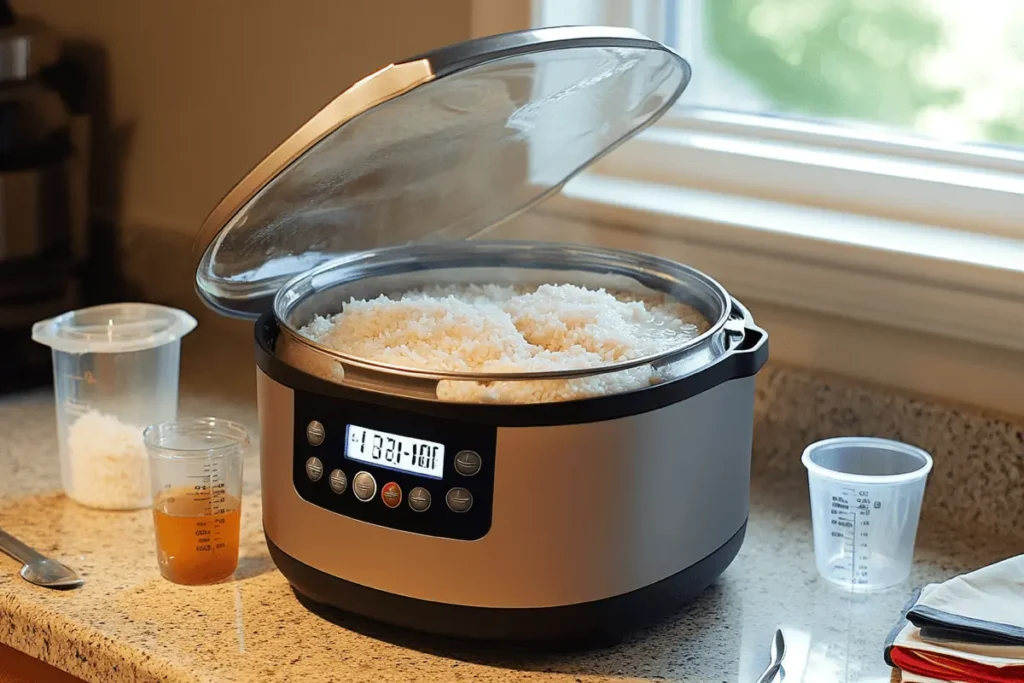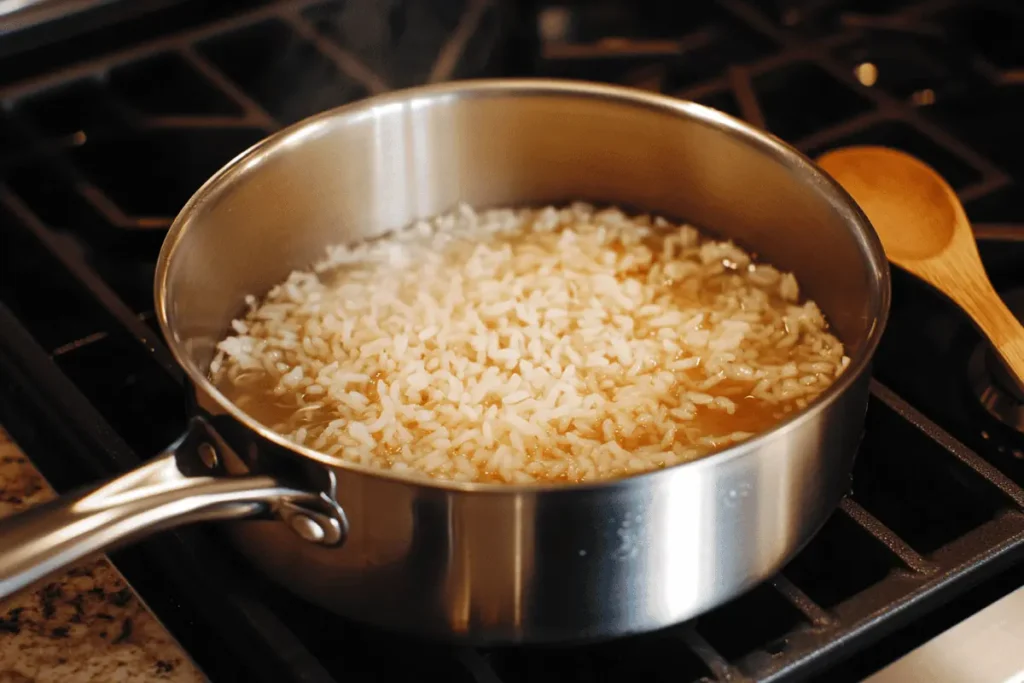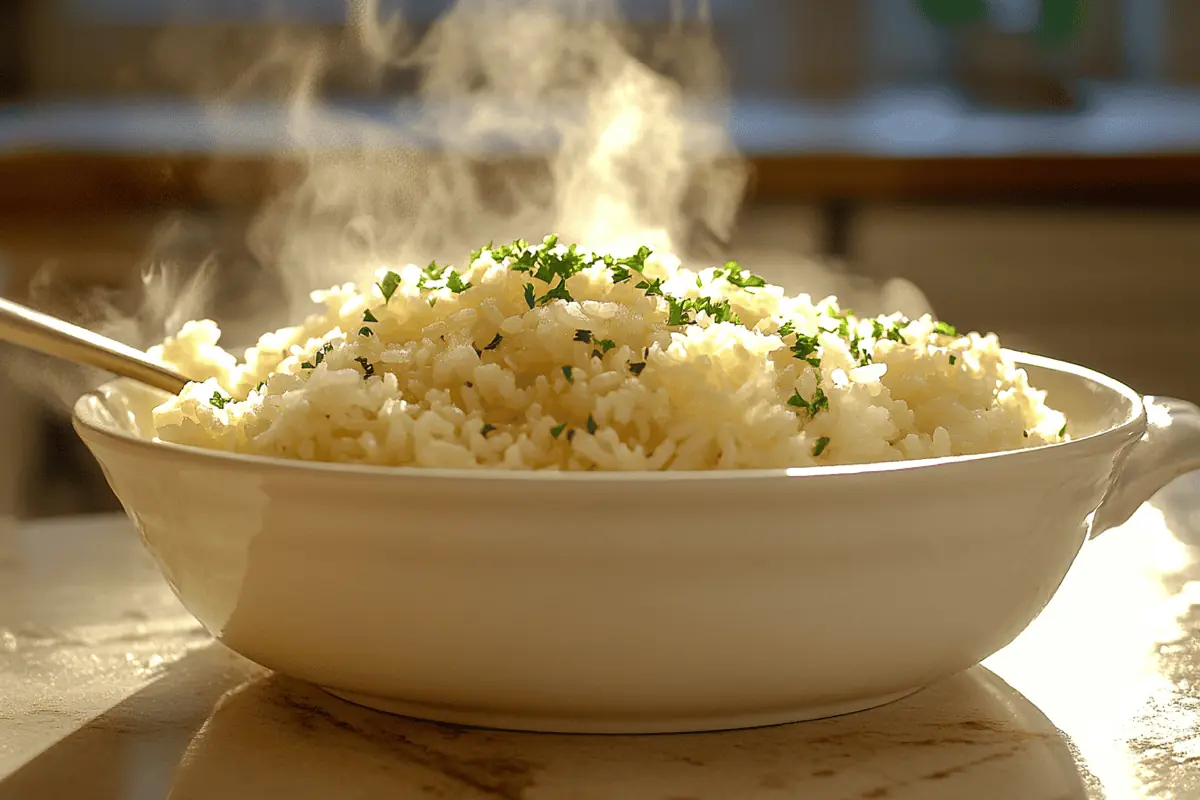Many people love rice, yet they sometimes wish it had more flavor. Learning how to make rice with chicken stock solves that problem. By cooking rice in chicken stock, you add a rich taste that enhances every bite. You can also customize the dish with spices or vegetables. Indeed, chicken stock rice is a simple method for turning a side dish into a highlight. Moreover, you can do it in a pot on your stovetop or opt for a rice cooker chicken broth method. This technique is flexible, quick, and budget-friendly.
In this article, we will explore how to use chicken broth or stock, share tips for adding flavor, and suggest ways to customize your chicken flavored rice recipe. We will also address common questions, such as “can you cook rice with chicken stock?” or “can I cook rice in chicken broth?” By the end, you will feel confident about your ability to create a fluffy, savory bowl of rice made with chicken stock.
Additionally, you will learn how to incorporate extras like onions, herbs, or lemon zest. These small tweaks can produce bold, aromatic rice that pairs well with roasted chicken, beef stew, or lighter meals. Meanwhile, we will tackle different cooking methods, including stovetop simmering and making chicken flavored rice in rice cooker. You will also discover how to measure stock accurately, ensuring your final dish is not too salty or bland. Finally, this article will discuss the idea of using bouillon, so you know how much chicken bouillon per cup of rice might yield the best flavor. Let’s begin with the basics.
Table of contents
Why Rice Made with Chicken Broth Tastes Better
Cooking rice in chicken stock adds depth and warmth to an otherwise neutral dish. Normally, plain rice is made with just water. While that yields a mild, versatile flavor, it lacks the satisfying notes of a seasoned stock. When you cook rice in stock, each grain absorbs the savory essence of chicken. As a result, the final dish has a richer taste. If you want even more flavor, you can add spices like garlic powder, onion powder, or dried herbs. You can also incorporate vegetables or small bits of meat for a more complete chicken broth rice recipe.
Stock vs. Broth
You might wonder if it matters whether you use broth or stock. Both are flavorful liquids made from simmering chicken bones, meat, or vegetables in water. Yet, stock often uses bones and has a thicker feel. Broth may be lighter. Either one works for rice made with chicken broth or stock. Because the terms are sometimes used interchangeably in stores, you do not have to worry too much about the difference. If the container says “chicken stock” or “chicken broth,” you can still create chicken flavored rice. Just read the label to check how salty it is.
Can I Make Rice with Chicken Broth Every Time?
Yes, you can. Some people always choose stock or broth as their liquid when cooking rice. Doing so brings a quick burst of flavor to all sorts of meals. Indeed, rice is a staple in many households. Therefore, it is smart to find ways to make it more interesting. If you keep a carton of stock in your fridge or pantry, you can use it whenever you cook rice.
If you do not have liquid stock, you could use dry bouillon. Then, you add water. In that case, you might ask how much chicken bouillon per cup of rice is needed. Typically, a teaspoon or so per cup of liquid is enough. However, check the package directions for your specific brand.
Basic Steps: How to Make Rice with Chicken Stock
Below is a simple process for cooking rice in stock on the stovetop. It provides a straightforward way to get moist, tasty rice:
- Measure Your Rice: Choose your preferred type of rice. Many people use long-grain white rice for chicken stock rice. But basmati or jasmine also work well. Measure the dry rice accurately. A standard serving is about 1 cup of uncooked rice for 2-3 people.
- Rinse or Not: Some cooks rinse their rice to remove excess starch. Rinsing can lead to fluffier grains. Others skip rinsing to keep more texture. Decide based on your preference.
- Pick Your Liquid: You can use store-bought chicken stock, homemade broth, or even bouillon mixed with water. Ensure your stock is not too salty or consider a low-sodium version. That helps you control the salt level. For 1 cup of rice, most people use about 2 cups of liquid. If you do not rinse your rice, you might need a bit more liquid.
- Sauté Optional: You can briefly sauté your rice in oil or butter before adding the stock. This step can enhance flavor by toasting the grains. You can also add aromatics like chopped onions or garlic at this point.
- Add the Stock: Once your rice is in the pot (or pan), pour in chicken broth in rice. Bring it to a gentle boil.
- Reduce Heat and Cover: Lower the heat to a simmer, then cover with a tight-fitting lid. Cook for about 15-20 minutes, or until the liquid is absorbed. Different types of rice vary, so adjust the cooking time as needed.
- Rest and Fluff: Once done, remove the pot from heat and let it rest, covered, for 5 minutes. Then, fluff gently with a fork. Your rice with chicken broth should now be fragrant, soft, and savory.

Chicken Flavored Rice Recipe Variations
You can customize your chicken broth rice recipe in many ways. Below are just a few suggestions:
- Herb-Infused: Add thyme, rosemary, or basil to the pot for a fresh, herbal note. You can stir in chopped parsley after cooking for a bright color.
- Vegetable Medley: Toss diced carrots, celery, or bell peppers into the pot. They will cook along with the rice and stock. This approach yields a one-pot meal that looks colorful and tastes hearty.
- Spicy Kick: If you enjoy heat, sprinkle in chili flakes or diced jalapeños. You can also stir in a bit of cumin for a southwestern spin.
- Citrus Zing: Grate some lemon or lime zest into the rice after cooking. The tangy aroma will contrast nicely with the chicken stock rice flavor.
- Creamy Style: Stir in a small amount of cream, sour cream, or cheese at the end. This method creates a comforting risotto-like dish without the effort of constant stirring.
In each of these variations, cooking rice in chicken stock remains central. That base lays the groundwork for you to layer more flavors. You can also keep it simple and serve your rice as is, perhaps with a pinch of black pepper or dried herbs on top.
Can You Cook Rice with Chicken Stock in a Rice Cooker?
Many wonder if they can use their rice cooker chicken broth method. Yes, you can. Simply measure your rice and place it in the cooker. Then, swap water for chicken stock or a mix of bouillon and water. Ensure you maintain the recommended liquid-to-rice ratio as outlined in your cooker’s instructions. Usually, if your manual says 1 cup of rice to 1 cup of water, you would use 1 cup of stock instead.
However, you might need to adjust the amount slightly, depending on how your machine handles moisture. It might be a good idea to consult the manufacturer’s guidelines if you are unsure. Some high-end machines even have a “soup” or “broth” setting, but standard models will handle chicken flavored rice in rice cooker just fine.
Rice with Chicken Broth in Rice Cooker Tips
- Rinse if You Like: As with stovetop methods, you can rinse or not. It depends on your desired texture.
- Mix Thoroughly: Stir the stock or bouillon solution into the rice so it is evenly distributed. This step helps prevent uneven cooking or hot spots.
- Add Ingredients: If you want vegetables, add them now. They will steam along with the rice.
- Close the Lid and Set: Choose the standard white rice setting if you have multiple settings. Let the machine run its cycle.
- Rest and Fluff: When the cooker finishes, let the rice sit for 5-10 minutes, then fluff. The result should be moist, fragrant rice made with chicken broth.

Chicken Stock Rice vs. Water: Nutritional Factors
Cooking rice in stock does more than just boost flavor. It can also add some extra nutrients, especially if you use a homemade or high-quality stock. Chicken stock often contains trace minerals from chicken bones and vegetables. However, the nutritional difference may be minor in the grand scheme. One concern might be sodium. Many store-bought stocks include a decent amount of salt. If you want to keep sodium in check, look for low-sodium or no-salt-added varieties. You can always season later if needed. Another factor is fat content, though most stocks are not very fatty. If you want to reduce fat, skim any fat off the top of homemade stock or choose a brand labeled “fat-free.”
How Much Chicken Bouillon per Cup of Rice?
If you do not have liquid stock, you can still cook rice in stock by mixing bouillon with water. Usually, the packaging will advise how much to use per cup of liquid. For instance, some brands say one teaspoon of bouillon paste per cup of water. Others might recommend a half teaspoon per 8 ounces of water. You can tweak the ratio to match your taste. Also, consider that bouillon tends to be salty. When you plan to cook rice in stock from bouillon, start with a small amount. Taste the mixture. If it seems bland, add a bit more. Over time, you will discover your personal sweet spot.
Step-by-Step Chicken Stock Rice Recipe
Below is a simple recipe that you can customize. We will use a stovetop approach:
- Gather Ingredients:
- 1 cup of long-grain white rice (rinsed if desired)
- 2 cups of chicken stock (or 2 cups water mixed with bouillon)
- 1 tablespoon butter or olive oil (optional)
- Salt and pepper to taste (optional, depending on stock salt level)
- Sauté (Optional): Heat the oil or butter in a medium saucepan over medium heat. Add the rice. Stir for about 2 minutes until the grains look slightly translucent. This step develops flavor and a faint nutty aroma.
- Add Chicken Stock: Pour in your stock or bouillon mixture. If you wonder, “can you boil rice in chicken stock from the start?” yes, you can. Also, check how salty the liquid is. If it’s already well-seasoned, you may not need extra salt.
- Bring to a Boil: Increase the heat until the mixture starts boiling. Immediately lower the heat to a gentle simmer.
- Cover and Cook: Put a tight-fitting lid on your saucepan. Let the rice cook for about 15-20 minutes. The time can vary depending on your rice type.
- Rest and Fluff: Turn off the heat and let the pot sit, covered, for 5 minutes. This resting period ensures each grain finishes steaming. Finally, fluff with a fork. Serve warm.
That’s all it takes to have a delicious chicken stock rice recipe. You can garnish with chopped parsley or green onions for extra freshness.

Creative Ways to Use Rice Bouillon
Rice bouillon refers to the practice of seasoning rice with bouillon instead of fresh or canned stock. This option is convenient if you do not keep stock on hand. You can add it directly to your cooking liquid or sprinkle it into the rice during cooking. Some bouillon is in powder form, and some is in paste or cube form. The main advantage is long shelf life. Additionally, you can measure small amounts, controlling the flavor intensity. However, keep an eye on the sodium content. Checking labels is always wise.
Other Flavor Enhancers
While bouillon can do wonders for your chicken flavored rice in rice cooker or on the stove, you can also experiment with homemade stock. Simmer leftover chicken bones with aromatic vegetables like onions, carrots, and celery for a few hours. Strain out the solids, and you have a custom base for cooking rice. You can freeze the stock in portions to use later. Another tip is to add herbs such as thyme or bay leaves when you cook rice in stock. These subtle accents help deliver a more complex profile to your dish.
Rice Made with Chicken Broth for Meal Prep
If you enjoy meal prepping, consider cooking a large batch of chicken flavored rice recipe. Then, divide it into individual containers. Pair the rice with lean proteins such as grilled chicken, fish, or tofu. Add steamed vegetables or a side salad. When you reheat the meal, the rice remains moist and tasty because it was cooked in broth. This method can save you time on busy weekdays, while ensuring you have a balanced meal. If you prefer a vegetarian dish, you can use vegetable stock or skip the chicken part. Yet, the technique of cooking rice in stock remains the same.
Storing and Reheating Tips
You can keep cooked rice in the fridge for about 4-5 days. Store it in airtight containers. When reheating, add a splash of water or more stock to restore moisture. You can reheat on the stovetop or in the microwave. Stir halfway through to distribute the heat evenly. If you plan to freeze the rice, spread it on a baking sheet to cool quickly, then transfer to freezer-safe bags. Thaw in the fridge overnight, or use a microwave defrost setting. Fluff again before serving. The flavor from the chicken stock tends to remain even after storage.
Common Pitfalls and How to Avoid Them
- Overly Salty Rice: Chicken broth or bouillon can be high in salt. Choose low-sodium varieties or add less bouillon if the brand is strong. Taste before salting.
- Mushy Grains: Using too much liquid or cooking too long can lead to soft, mushy rice. Follow the recommended ratio and keep an eye on the cooking time.
- Scorched Bottom: If the heat is too high or the lid is not tight, the bottom can burn. Cook on low once it starts boiling. A heavy-bottomed pan can help.
- Flavor Not Strong Enough: If your chicken broth in rice tastes weak, try reducing the liquid or adding more bouillon. You can also sauté onions or garlic in butter first.
Conclusion
Now that you know how to make rice with chicken stock, you can easily upgrade your meals. By swapping water for savory liquid, you infuse each grain with flavor. You can keep it simple or create bold variations by adding herbs, vegetables, or spices.
Additionally, you can explore the convenience of rice made with chicken broth in a rice cooker or try bouillon if fresh stock is not available. No matter the method, chicken stock rice stands out as a warm, comforting side dish or base for hearty bowls. Best of all, it requires minimal effort. So, the next time you plan to cook rice, consider using chicken broth. Your taste buds will thank you for it.
Enjoy experimenting with different add-ins and watch your family or friends reach for second helpings. After a few tries, you will see how easy it is to produce a consistent, delicious outcome every time.
Frequently Asked Questions
Can I use chicken stock instead of water to cook rice?
Yes. Using chicken stock instead of water adds savory depth and makes the rice more flavorful.
How much chicken stock for 1 cup of rice?
Most people use about 2 cups of stock for 1 cup of rice. You can adjust based on the rice type or how firm you want the grains.
Can you substitute chicken stock for water?
Yes. It is a direct replacement. Just ensure you monitor salt levels, especially if the stock is already seasoned.
Is it good to cook rice in broth?
Yes. Cooking rice in broth elevates the taste. It delivers a rich, comforting profile that plain water cannot match.

